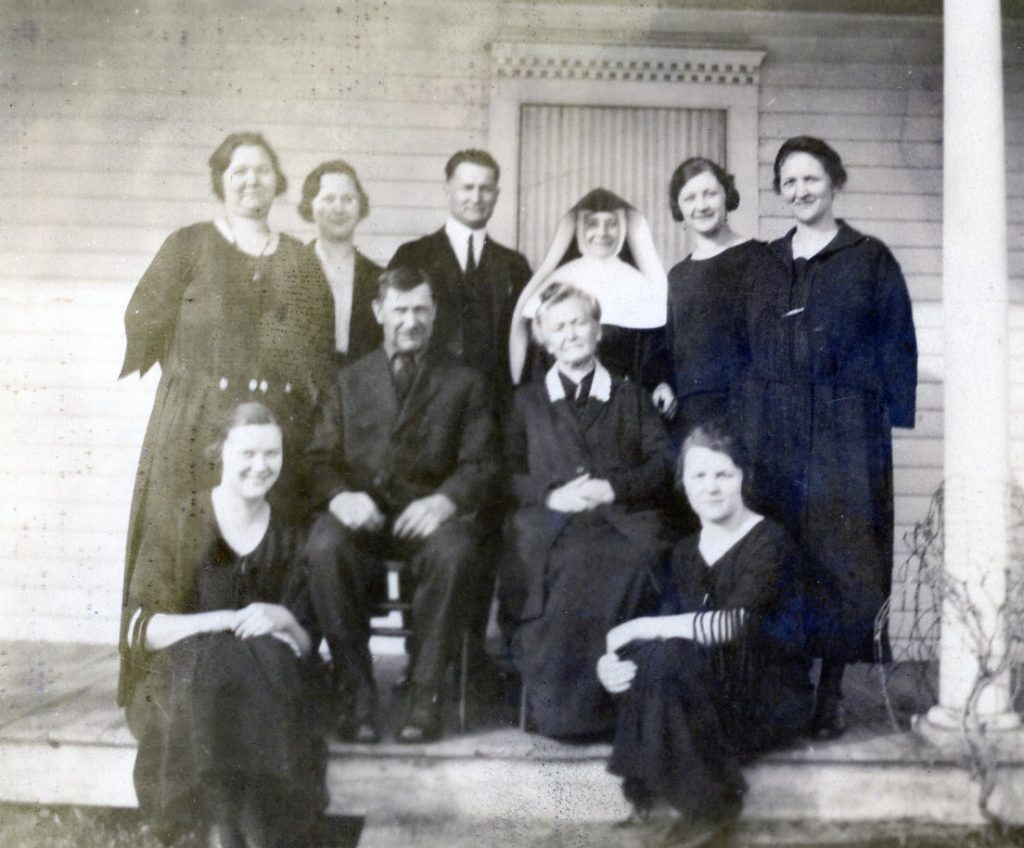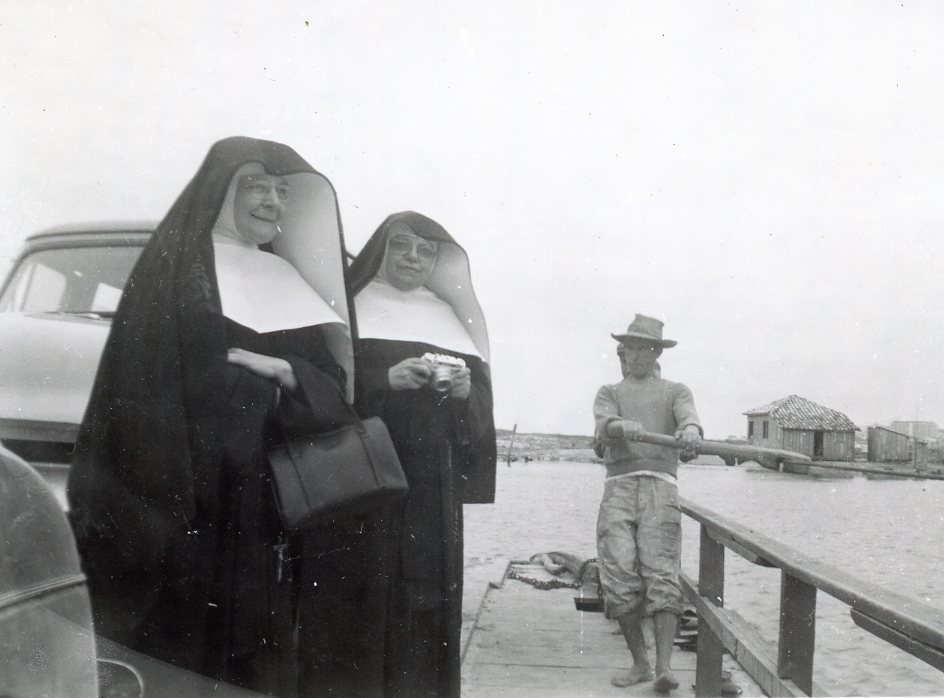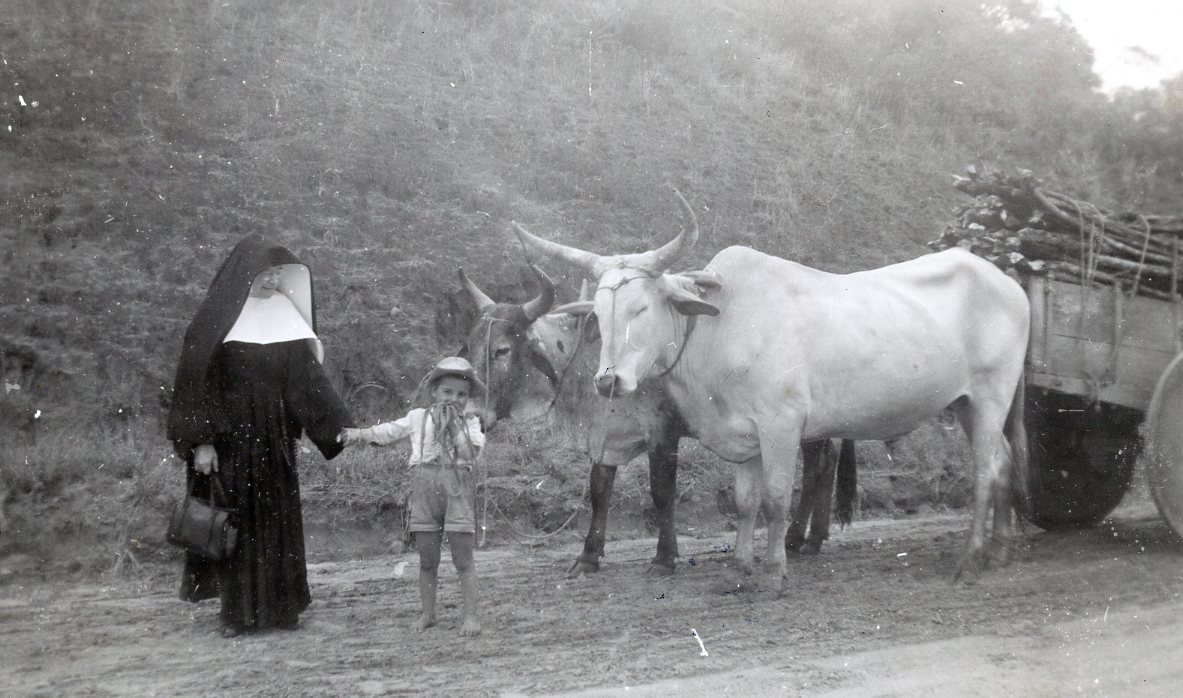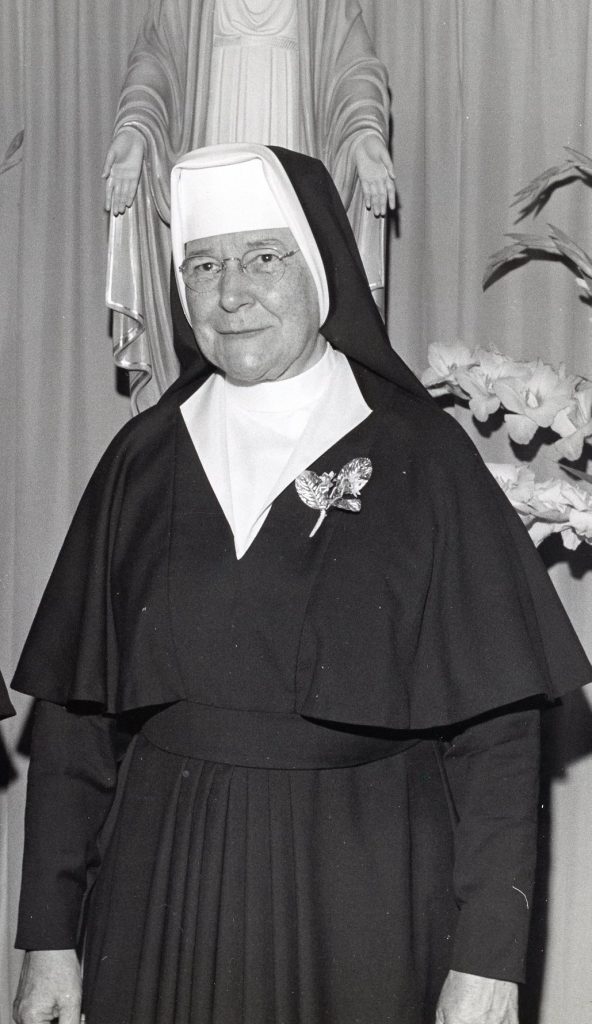By Tim Cary, Archivist
The series of articles over the past year acknowledging the 175th anniversary of the School Sisters of Notre Dame arrival in North America has sought to explore interesting SSND “firsts.” A discussion of such firsts would be incomplete without Mother Ambrosia Roecklein, who accomplished many firsts. She was the first North American sister to be elected to the General Council (1951-1956) and to serve as General Superior (1956-1968). She was the first General Superior to visit the sisters in South America, the first to fly on a jet plane for those visits, and the first to live at the Generalate in Rome.
The future General Superior of the congregation, Mother Ambrosia was born in 1893 in the tiny town of Hewitt, Wisconsin. She grew up in a farm family to parents who were born in Bavaria. She was educated entirely in Catholic schools, receiving degrees from Mount Mary College (now University in Milwaukee, Wisconsin) and DePaul University (Chicago, Illinois). She entered the congregation in 1909 and professed first vows in 1913. She spoke German fluently, and her first teaching assignment was at St. Anthony, a German parish in Milwaukee. Mother Ambrosia professed her final vows in 1921, and for the next 30-plus years was a teacher and superior at schools in Wisconsin, Illinois and Indiana. In 1951 Sister Ambrosia was elected a North American representative to the Generalate, which was then located in Munich. In 1956 she was elected General Superior, a position she held for two terms, until October 1968.
Prior to Mother Ambrosia’s election in 1956, only German sisters had served as General Superior. Why was she elected? In Sister Mary Erica Schmidter’s (Vicar General at the time of Mother Ambrosia’s death) words, “Mother Ambrosia was truly American, yet she belonged to the European culture, too. She was of German descent, and she spoke our language, and she lived in our country for five years before she came into office, thus uniting the two cultural elements in her person. She really became the instrument and symbol of unity, the firm liaison between the American and European Sisters.”
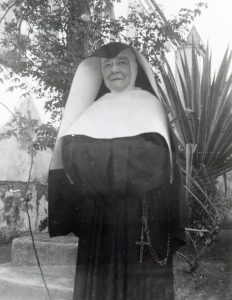
This 1957 photo is captioned, “This is M. M. Ambrosia, and she is all that she looks, charming simplicity combined with deep piety and a love for Notre Dame.”
The 1950s and 1960s were important years for the congregation, and the Catholic Church, yet little has been written about Mother Ambrosia’s contributions to the congregation during that time. Her life and career deserve examination. This short article is meant to introduce her and to highlight some of the significant issues that she dealt with during her time as General Superior. Circular letters are a logical place to look to learn about Mother Ambrosia’s actions, her relationship with the sisters, her fields of interest, etc.
Circular letters in Mother Ambrosia’s time were kind of like today’s “blogs.” They were used to disseminate information to the sisters in a timely manner. She wrote about 60 of them. They appeared irregularly and tended to be informative, encouraging, serious, and at times, light-hearted on topics of interest to SSND. The letters often included information on her activities and travels, updates on issues of ongoing concern and tidbits on recent congregational developments. They frequently offered words of encouragement regarding what sisters might do to strengthen their commitment to God, Jesus and Mary, and their personal growth in the congregation.
Quoting from Mother Ambrosia’s circular letters allows one to see how she kept the congregation informed on significant issues of her administration. This article looks at four topics that appear consistently in the letters: the Generalate’s move from Munich to Rome, the congregation’s change of habit, SSND activities in Central and South America, and the community’s responses to changes initiated by the Second Vatican Council.
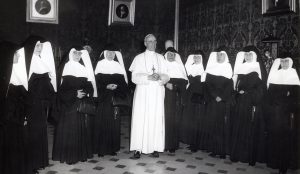
The Generalate staff and Mother Ambrosia (fourth from left) were invited to the Vatican by Pope Pius XII shortly after their move to Rome in July 1957.
Generalate Move to Rome
The congregation began in Neunburg vorm Wald, Germany, in 1833. In 1843, the sisters (and the Generalate) moved to Munich. After more than a century in Munich, the decision to move it to Rome was not taken lightly. It was common for Mother Ambrosia’s letters to mention Generalate activities in Rome. She wrote of the status of the new building they would move into, and of her frustration at the length of time it took Italian builders and officials to accomplish their tasks. While she clearly loved Rome, she also understood the feelings of the German sisters when the Generalate left their country. Still, Mother Ambrosia was proud of the SSND presence in Rome. She wanted all the sisters to consider the Generalate to be their home in Rome.
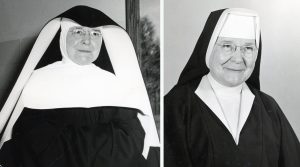
Left: Mother Ambrosia in 1959 wearing the unaltered habit. Right: Mother Ambrosia in 1963 wearing the “new” habit.
Change of Habit
The sisters’ habit had gone basically unchanged since the founding of the congregation in 1833. Any suggestion of change to this venerable garb was bound to grab the community’s attention. In 1952 the Vatican made clear that each congregation was responsible for their own habit. Alterations would be allowed, but the decision to change had to be unanimous. By the late 1950s, the sisters clearly wanted to make modifications to their habit. Mother Ambrosia approved a modified habit, but she cautioned that new garb would not change the fundamental mission of the congregation. The sisters must remain ready to do battle for Christ.
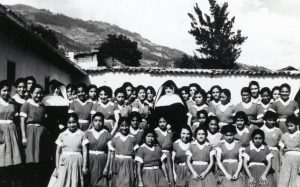
This photograph, taken in 1962, shows Mother Bernardia (left) and Mother Ambrosia surrounded by school children in Guatemala.
Latin and South America
The Congregation has had a presence in Central and South America since the 1930s, when Bavarian sisters, fleeing Nazi Germany, established missions in Brazil and Argentina. North American SSND first worked in Honduras in 1952 and established a mission there in 1956. By the mid-1960s, American sisters had established a presence in eight countries. Much of this activity was in response to Pope John XXIII who was concerned about the rise of evangelical churches in the region as well as the spread of communism. In the late 1950s, he urged religious communities to send missionaries to Central and South America. In 1961 he called for congregations in the United States to send 10% of their members there within the decade. Mother Ambrosia was aware of the Holy Father’s concern, and in her circular letters mentions the congregation’s missionaries there, the good work they were doing, the need for more volunteers and ongoing financial support.
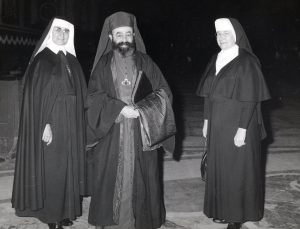
Mother Ambrosia (right) with two unidentified people attending a Vatican II session on November 11, 1965.
Vatican Council II
The Vatican Council (October 1962-December 1965) is not usually mentioned by name in the circulars but is often alluded to. Mother Ambrosia was aware of the Council’s activities, and she uses these letters to keep the sisters up to date on its activities, especially during 1965. She was supportive of the idea that the Church needed “updating” (aggiornamento), but was leery of moving too far, too quickly. Rather than addressing Council issues at the time they were raised, she sometimes “comments” on the Council’s aftermath as she sees it affecting the sisters.
Mother Ambrosia died January 4, 1973, in Elm Grove, Wisconsin. She is buried in the cemetery there in an oval plot. Mother Georgianne Segner wrote, “At one end of the oval rests Mother Caroline Friess, who left Germany to serve the needs of the missions in North America; at the other end, Mother M. Ambrosia Roecklein, who left North America to serve the needs of our Congregation at its headquarters in Munich, Germany, and Rome, Italy…. She traveled all over the world, thus broadening her vision of the needs of the Church universal. Through her world vision she initiated the opening of missions in eight countries of Latin America, established three new provinces in North America, and named seven cultural areas of the Congregation as regions. These provinces and regions allowed for greater decentralization and personal responsibility. And she did most of this before the completion of Vatican II.”
The circulars only begin to tell the story of Mother Ambrosia’s contributions to the congregation. In the letters she is part teacher, part cheerleader, part newscaster and part mother. They provide insight into the issues that interested her and were important to the congregation. She was not against change, but she did not seek it. A quote from her final circular letter (December 30, 1968) embodies her simple, abiding love for the congregation:
“True, the time of office is over, but you will always share in my prayer. I promise that at nine o’clock each evening…. I will bless you Sisters with: The blessing of the Father, the love of the Son, the power of the Holy Spirit, the protection of the Blessed Virgin Mary, the intercession of the Angels and Saints be with you always and everywhere.”

